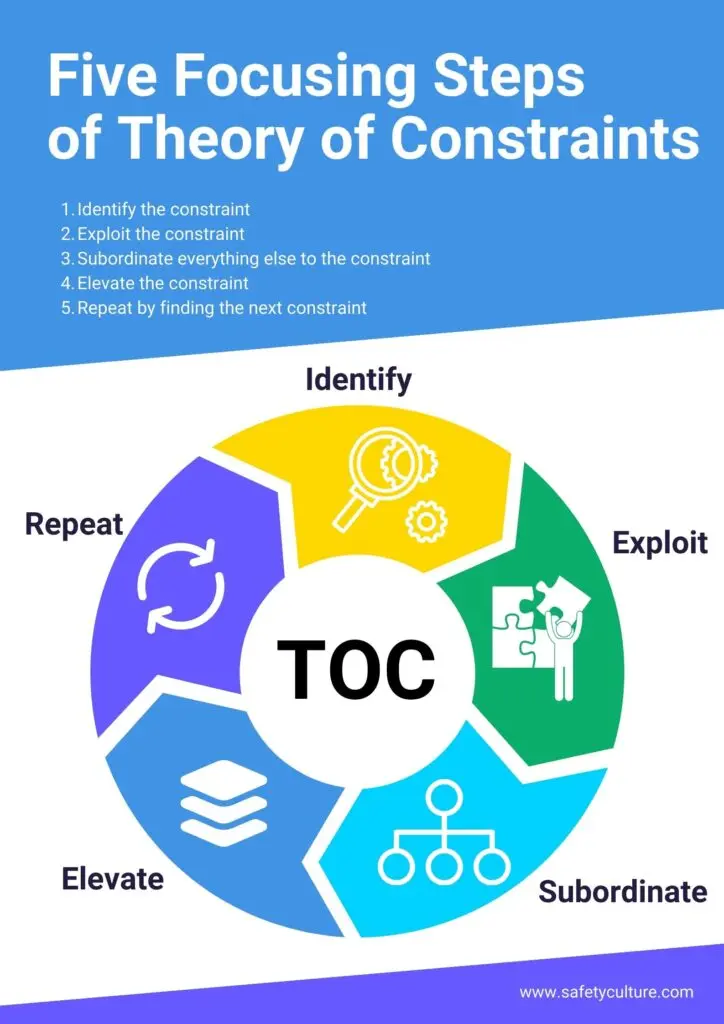What is Theory of Constraints?
Theory of Constraints (TOC) is a methodology for improving processes that focus on identifying and correcting constraints or root causes of bottlenecks. By addressing these constraints, TOC can help businesses become more profitable and organizations more efficient in achieving their goals.
What is the Primary Goal of the Theory of Constraints?
The goal of Theory of Constraints is to help businesses increase throughput and guide organizations toward realizing their goals by addressing constraints through the improvement of their processes and by optimizing the use of their resources.
Which Industries Apply Theory of Constraints?
Popular in the manufacturing industry, Theory of Constraints can be applied in any industry that is concerned with throughput. Organizations that wish to optimize their processes can benefit from applying the Theory of Constraints methodology and consultants can help business owners understand the concept of TOC.
How do I Apply Theory of Constraints to my Job?
Some of the questions concerning Theory of Constraints are how does it apply to one’s job and what does it mean for one’s work. Its practical application depends on what constraint you intend to work on, which focusing step you are currently in, and what type of tools you are using. As a method that ultimately intends to increase profits, check the section on the 5 steps of TOC.
What are the 5 Steps of Theory of Constraints?
The original expression of Theory of Constraints and also called the 5 focusing steps of TOC, the 5 steps are as follows:
Step 1: Identify the Constraint
Going back to the concept of the chain, identify the weakest link. Determine which part of your business process or stage in your manufacturing assembly has the biggest bottleneck that, if resolved, can get you the best continuous improvement overall.
You can do a Gemba Walk, wherein you will literally take a walk on the production floor, immersing yourself in what’s really happening, and record your observations.
The Hansei approach can also help determine constraints that may be coming from a more personal level. Although Hansei is one of the keys of Kaizen (often associated with the lean method e.g. lean manufacturing), it can be used as another approach for step 1.
For production areas where the Andon system is used, utilize the data collected from the Andon system to help determine where bottlenecks typically occur. You can then coordinate with operations supervisors and determine the best course of action to exploit a specific constraint.
When trying to identify the weakest link in your processes or in your manufacturing assembly line, you need to collect and analyze data. Ask which step in the entire process has the best potential to increase throughput should it get optimized.
Step 2: Exploit the Constraint
Also called optimizing the constraint, this is the step where you find ways to resolve the issue using the resources you currently have at your disposal.
You can apply the Kaizen philosophy at this step where small incremental changes applied can make an impact.
Make sure that the actions taken at step 2 will not adversely affect other processes or overburden the constraint.
Step 3: Subordinate Everything Else to the Constraint
Imagining the chain, subordinate everything else to the constraint by avoiding changes anywhere that may overload the constraint. Any changes should be working to support the constraint.
Step 4: Elevate the Constraint
When the exploit and subordinate steps are successful in improving the constraint, then it’s time to consider elevating the constraint.
Elevating the constraint may mean investing more resources to increase its capacity or output. It’s worth noting that the return of investment should be reviewed when adding resources to elevate the constraint.
Some tools you can use for step 4 are Poka Yoke, Total Productive Maintenance (TPM), and Single-Minute Exchange of Dies (SMED), another lean tool.
Step 5: Repeat by Finding the Next Constraint
In order for a business to further increase profitability and for an organization to reach other goals after you break a constraint (meaning it’s no longer a constraint at this stage), you find the next constraint to solve and repeat step 1.
Follow the 5 Steps
Complete the 5 steps of Theory of Constraints with our digital platform.
Get Started for FreePractical Tool for Applying the Theory of Constraints Methodology
Constraints need to be identified before they can be worked on and actions need to be monitored to make sure that they are effective against the constraints. SafetyCulture (formerly iAuditor) is a powerful tool that can help organizations make sure that actions are properly implemented and verify that they are effectively impacting the constraint.
Ideal for teams, you can use the SafetyCulture online or offline on mobile to monitor performance and collect data that can be analyzed to measure impact. Data collected over time can then be used for training and continuous actions against other constraints, increasing throughput and further improving and streamlining processes that boost productivity and elevate the quality of products and services.
Theory of Constraints FAQ’s
Let’s quickly answer some questions regarding TOC before we discuss further and cover its primary goal, its 5 steps or original expression, and the tools that can be used for the practical application of TOC.
Throughput is the rate of profitability through the sales of products and services. It is the rate of producing something within a specific period of time.
The literal definition of constraint is that it is a limitation or a restriction. To better explain constraint in the context of TOC (deriving from an example of the Theory of Constraints Institute), imagine a chain and its weakest link. By identifying which is the chain’s weakest link and strengthening only that one link, you will be able to increase the strength of the whole chain.
In a business process or a manufacturing assembly line, identifying what is the weakest link (constraint) and focusing on improving it will help elevate the overall performance of the business and increase its throughput.
TOC came about when Dr. Eliyahu Goldratt wrote his book “The Goal” where he introduced the idea of focusing on increasing profit, not on reducing cost. Companies have since benefited from adapting this concept into their business processes.
In project management, TOC is continuously applied to identify and address or eliminate all constraints that limit performance.
While both TOC and lean ultimately improve the processes of organizations to the benefit of customers, lean thinking is more about eliminating waste while TOC is more about eliminating constraints.




